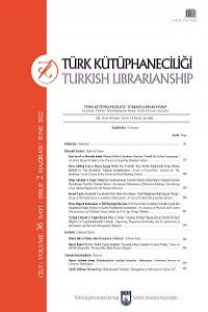Usability of Electronic Records Management System (ERMS) of the Republic of Turkey Ministry of Health
usability, electronic records management systems, ERMS of Republic of Turkey Ministry of Health
Usability of Electronic Records Management System (ERMS) of the Republic of Turkey Ministry of Health
usability, electronic records management systems, ERMS of Republic of Turkey Ministry of Health,
___
- Bevan, N., Kirakowski, J. and Maissel, J. (1991). What is Usability? Available at: https://pdfs.semanticscholar.org/6ebb/47bcbe8fbe3f427fef4c0ecb3235e206d15d.pdf
- Bikson, T. K. (1994). Organizational trends and electronic media: work in progress. The American Archivist, 57(1), 48-68.
- Brown, T.E. (1993). A decade of development: educational programs for automated records a techniques within the Society of American Archivists'. American
- Archivist; 56(3), 410-423. Available at https://americanarchivist.org/doi/pdf/10.17723/aarc.56.3.3302282246h65268
- Ceaparu, I., Lazar, J., Bessiere, K., Robinson, J. and Shneiderman, B. (2004). Determining causes and severity of end-user frustration. Available at: http://www.cs.umd.edu/hcil/trs/2002-11/2002-11.pdf
- Corrao, N.J., Robinson, A.G., Swiernik, M.A. and Naeim, A. (2010). Importance of testing for usability when selecting and implementing an electronic health or medical record system. Journal of Oncology Practice, 6(3), 120-124. Available at: https://www.ncbi.nlm.nih.gov/pmc/articles/PMC2868635/
- Demirtel, H. and Bayram, Ö. (2014). Elektronik belge yönetim sistemlerinin verimliliğe katkısı: Kalkınma Bakanlığı örneği. Bilgi Dünyası, 15(1), 91-101. Available at: http://bd.org.tr/index.php/bd/article/view/423
- Gregory, K. (2005). Implementing an electronic records management system: A public sector case study. Records Management Journal, 15(2), 80- 85. Available at: https://doi.org/10.1108/09565690510614229
- Hoxmeier, J. A. and DiCesare, C. (2000). System response time and user satisfaction: an experimental study of browser-based applications. M. Chung (Ed.), In Proceedings of the 6th Americas Conference on Information Systems , (p. 140-145). HLong Beach, CA. Available at: http://citeseerx.ist.psu.edu/viewdoc/download?doi=10.1.1.99.2770&rep=rep1&type=pdf
- Hung, S. Y., Tang, K. Z., Chang, C. M., and Ke, C. D. (2009). User acceptance of intergovernmental services: An example of electronic document management system. Government Information Quarterly, 26(2), 387-397. Available at: https://www.sciencedirect.com/science/article/pii/S0740624X08001627
- Johnston, G. P. and Bowen, D. V. (2005). The benefits of electronic records management systems: a general review of published and some unpublished cases. Records Management Journal, 15(3), 131-140. Available at: https://doi.org/10.1108/09565690510632319
- Kandur, H. (2011). Türkiye’de kamu kurumlarında elektronik belge yönetimi: mevcut durum analizi ve farkındalığın artırılması çalışmaları. Bilgi Dünyası, 12(1), 2-12. Available at: http://bd.org.tr/index.php/bd/article/view/6
- Kandur, H. (2016). Kamu kurumlarında elektronik belge yönetimi: güncel sorunlar ve geleceğe yönelik beklentiler. F. Özdemirci, N. Özel, T. Çakmak, Z. Akdoğan and Yalçınkaya (Ed.), e-Beyas 2015 Sempozyumu Kurumsal Belleklerin Geleceği: Dijitalleştirme-Elektronik Arşiv-Elektronik Belge Yönetimi (29-34) içinde. Ankara, Ankara Üniversitesi Belge Yönetim ve Arşiv Sistemi Koordinatörlüğü. Available at: http://2015.ebeyas.org/wp-content/uploads/2016/04/e-BEYAS2015_Bildiriler.pdf
- Karagöz, A. (2013). A usability study on electronic document management system in Middle East Technical University (Master Thesis). Available at: http://etd.lib.metu.edu.tr/upload/12616524/index.pdf
- Külcü, Özgür. (2009a). Evolution of the e-records management practices in e-government: reflections from Turkey.The Electronic Library, 27 (6), 999-1009. Available at: http://www.bby.hacettepe.edu.tr/yayinlar/dosyalar/Evolution_of.pdf
- Külcü, Özgür. (2009b). Quality documentation and records management: A survey of Turkish universities. Aslib Proceedings, 61 (6), 459-473. Available at: https://www.emeraldinsight.com/doi/abs/10.1108/00012530910989616
- Lior, L.N. (2013). Evaluating your information experience. In, Writing for interaction: Crafting the Information Experience for Webb and Software Apps (p. 241-261). USA: Elsevier. Available at: https://www.sciencedirect.com/science/article/pii/B9780123948137000122
- Nielsen, J. (1999). Trust or bust: Communicating trustworthiness in web design. Available at: https://www.nngroup.com/articles/trustworthy-design/
- Ovaska, S. (1991). Usability as a goal for the design of computer systems. Scandinavian Journal of Information Systems, 3, 47-62. Available at: https://pdfs.semanticscholar.org/8594/d5e5ea801d4aa1d5a85f40b73cb3e6a4bb15.pdf
- Önaçan, M. B. K. (2012). Kamu kurumları arasında elektronik belge alışverişi ile ilgili mevzuat ve kamu kurumlarında yapılması gerekenler. Bilgi Dünyası, 13(2), 494-506. Available at: http://bd.org.tr/index.php/bd/article/view/81
- Özdemirci, F. (2003). İlk uluslararası belge yönetim standardı: ülkemiz açısından bir değerlendirme. Türk Kütüphaneciliği, 17(3), 225-246. Available at: http://www.tk.org.tr/index.php/TK/article/view/264
- Özdemirci, F. and Bayram, Ö. (2009). Approaches of e-records management in e-state transformation process in Turkey. In: Lytras M.D., Ordonez de Pablos P.,
- Damiani E., Avison D., Naeve A., Horner D.G. (Eds), Best Practices for the Knowledge Society. Knowledge, Learning, Development and Technology for All. WSKS 2009. Communications in Computer and Information Science, 49, 395-403. Springer, Berlin, Heidelberg Available at: https://link.springer.com/chapter/10.1007/978-3-642-04757-2_42
- Su, T.J., Wang, S.M., Chen, Y.F., Tsou, T.Y., and Cheng, J.C. (2017). Investigating the usability of electronic records management systems in government organizations from a human factor engineering perspective. Journal of Advanced Management Science, 5(1), 14-18. Available at: https://pdfs.semanticscholar.org/d8f2/284ad30e7f28bbe5f750f52c3b8df90db53b.pdf
- Tahtalıoğlu, H. (2018). Türkiye’de elektronik belge yönetim sisteminin kamu personeli tarafından benimsenmesinde eğitim faktörü. Yasama Dergisi, 37, 124-147. Available at: http://www.yasader.org/web/yasama_dergisi/2018/sayi37/sayi37_124-147.pdf
- Tamtürk, E. (2017). Kamu Yönetiminde Elektronik Belge Yönetim Sistemi. Journal of Social Sciences of Muş Alparslan University, 5(3), 851-863. Available at: http://dergipark.gov.tr/download/article-file/325152
- The ISO/IEC 9126-4 Standard. (2004). Technical report. Available at: https://www.sis.se/api/document/preview/904663/
- Tiitinen, P., Lyytikäinen, V., Päivärinta, T. and Salminen, A. (2000). User needs for electronic document management in the public administration: A study of two cases. Available at: https://aisel.aisnet.org/cgi/viewcontent.cgi?article=1161&context=ecis2000
- Yalçınkaya, B. (2016). Elektronik belge yönetim sistemi EBYS uygulamalarında başarı faktörü ve fayda analizi. AJIT-e: Online Academic Journal of Information Technology, 7,(23), 67-96.
- Yatin, S.F.M, Ramli, A.A.M., Hashim, H., Kadir, W.A. (2015). Electronic records management system: Malaysian experience. Australian Journal of Basic and Applied Sciences,9(3), 82-89. Available at: https://www.researchgate.net/publication/272172912_Electronic_Document_Management System_Malaysian_Experience
- Yıldırım, A. and Şimşek, H. (2000). Sosyal bilimlerde nitel araştırma yöntemleri. Ankara: Seçkin Yayınevi.
- Yüksek Planlama Kurulu. (2005). e-Dönüşüm Türkiye Projesi 2005 Yılı Eylem Planı. Yüksek Planlama Kurulu karar tarihi: 24/3/2005, Karar no: 2005/5. Available at: http://www.resmigazete.gov.tr/Eskiler/2005/04/20050401-12.htm
- Yayın Aralığı: 4
- Başlangıç: 1952
- Yayıncı: Türk Kütüphaneciler Derneği
Bir Zamanlar İstanbul Çocuk Kitapları Fuarı: Prof. Dr. Meral Alpay’ın Anısına!
Gerçek Bir Aydın: Prof. Dr. Meral Alpay Şenöz
İstanbul Üniversitesi Kütüphane ve Dokümantasyon Daire Başkanı Olarak Hocam Meral Alpay
Orta Asya’nın Kalbi Kazakistan’dan Kütüphane Ziyaretlerimize İlişkin Yansımalar
Demet SOYLU, Tunç Durmuş MEDENİ, Gulzhamal JAPAROVA, Rakhila RAKHMETOVA
Mavi Gözlü, Yüce Gönüllü Bir Melek
Meral Alpay’ın Kütüphanecilik Terimleri Sözlüğündeki Kimi Sözcüklerin Etimolojisi
Türkiye’de Kütüphane ve Bilgibilimi Araştırmalarında Kuram Kullanımı: Bir İçerik Analizi
Hülya KARTAL, Fatih GÜNER, Cemal ÇELİK, Mehmet SOYUÇOK, Reis BEŞER
